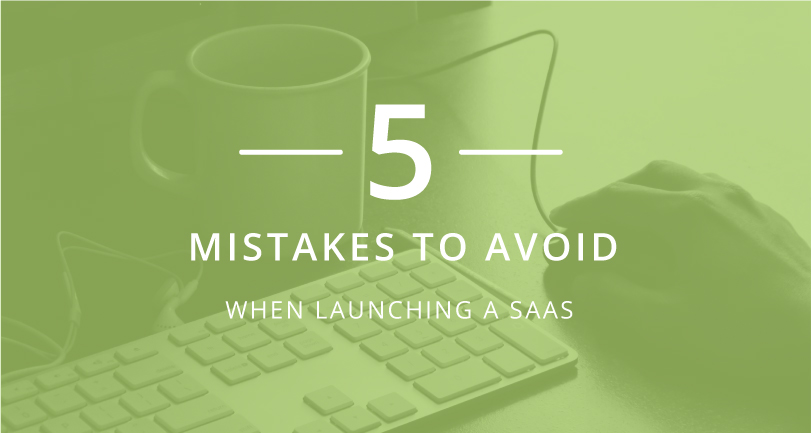
You’re launching your SaaS; this is a big moment! You’ve put a lot of blood, sweat, and tears into this (well, hopefully not any blood) and you’re ready to go public with all of your hard work.
However, there are a few things that could really hurt the integrity and success of your SaaS. So here is a short list of mistakes to avoid when launching a SaaS.
 Mistake #1 – Not taking advantage of resources.
Mistake #1 – Not taking advantage of resources.
Specifically, not taking advantage of outsource teams that do what you can’t . Stick to what you do best and hire someone else to do the rest.
Outsource teams typically have experience working together, know each other’s strengths and weaknesses, have a specific process for getting work done, and are likely more knowledgeable about building a SaaS than you are. Don’t write-off an outsource team just because you would rather do it yourself. The integrity and quality of your system may depend on it.
Mistake #2 – Missing your launch window.
Launching too early or too late can mean the difference between having a successful SaaS and having a fun little project that no one will ever use.
If you launch before the system is really ready, you run the risk of rolling out a sub-par product that won’t shine among its competitors. However, if you launch too late, similar products may saturate the market, making it nearly impossible for your stellar product to stand out in the crowd.
Taking a shortcut or two (or five) is likely to happen, just be extremely selective in which areas you make the cuts. And make sure that you don’t sacrifice customer experience for the sake of meeting your original launch date. It’s not worth it.
 Mistake #3 – “If you build it, they will come.”
Mistake #3 – “If you build it, they will come.”
Well, not necessarily. As much as we would all like for all of our business ventures to automatically attract the masses, life, unfortunately, doesn’t work out like that.
Normal marketing rules still apply here. Price your SaaS fairly, be disciplined in your sales and aggressive in your promotional strategies. Remember, determine your target market before anything else. If you don’t, you’ll just be shooting blind.
Mistake #4 – Neglecting to formulate an on-boarding process.
If you create a SaaS but have no game plan for when all of the sales start rolling in, you’ve just shot yourself in the foot.
Customers expect to receive a workable product with clear starting process when they sign up and shell out their hard-earned cash. This could manifest in the form of a FAQs sheet, a user manual, tutorials, or case studies.
Whatever you do, don’t just give the customer a product with the assumption that they will automatically know how to set it up, run it, and work with it. Some customers won’t stick around long enough for you to formulate a process, so have it designed before you launch.
When we built MedRevUp.com, a patient experience and analysis tool that helps healthcare organizations understand their patient’s experiences while improving their social reviews, we spent a huge amount of time working on the onboarding process. The process of making it easy to sign up while simultaneously educating customers is a surprisingly difficult job, and it almost always takes multiple iterations to do it right.
Mistake #5 – Underestimating your time.
 Don’t just assume that the 3 hours you set aside for maintenance and customer support will suffice. Honestly, you should set aside at least a week or two after launch to handle initial customer support, fine-tuning the inevitable hiccups customers will encounter, and updating the product as needed.
Don’t just assume that the 3 hours you set aside for maintenance and customer support will suffice. Honestly, you should set aside at least a week or two after launch to handle initial customer support, fine-tuning the inevitable hiccups customers will encounter, and updating the product as needed.
You likely won’t get much else done; that’s just the reality. Your SaaS will require a lot of time and attention in the first few weeks, which will affect your productivity in other areas. If you give yourself some margin and plan for a drop in productivity for a couple of weeks, you can avoid a lot of stress and likely avoid a mess!
 Jason Long is the founder and CEO of BrainLeaf and an Information Architect as well as the Managing Partner at MedRevUp.com. A self-professed serial entrepreneur, he is always interested in new businesses, new ideas, and new ways to change the world. He has over 15 years of experience in design and development and has served in a variety of different roles ranging from designer to Information Architect to CEO. He spends most of his time focusing on the build and development of new ventures while trying to travel the world.
Jason Long is the founder and CEO of BrainLeaf and an Information Architect as well as the Managing Partner at MedRevUp.com. A self-professed serial entrepreneur, he is always interested in new businesses, new ideas, and new ways to change the world. He has over 15 years of experience in design and development and has served in a variety of different roles ranging from designer to Information Architect to CEO. He spends most of his time focusing on the build and development of new ventures while trying to travel the world.





